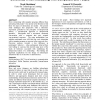5054 search results - page 1 / 1011 » How designers design and program interactive behaviors |
VL
2008
IEEE
13 years 11 months ago
2008
IEEE
Designers are skilled at sketching and prototyping the look of interfaces, but to explore various behaviors (what the interface does in response to input) typically requires progr...
VL
2008
IEEE
13 years 11 months ago
2008
IEEE
While a designer’s focus used to be the design of non-interactive elements such as graphics or animations, today’s designers deal with various levels of interactivity such as ...
HRI
2010
ACM
13 years 11 months ago
2010
ACM
—Robots are poised to enter our everyday environments such as our homes and offices, contexts that present unique questions such as the style of the robot’s actions. Style-orie...
CHI
2003
ACM
14 years 4 months ago
2003
ACM
How is interacting with computer programs different from interacting with people? One answer in the literature is that these two types of interactions are similar. The present stu...
CHI
2004
ACM
14 years 4 months ago
2004
ACM
Debugging is still among the most common and costly of programming activities. One reason is that current debugging tools do not directly support the inquisitive nature of the act...

